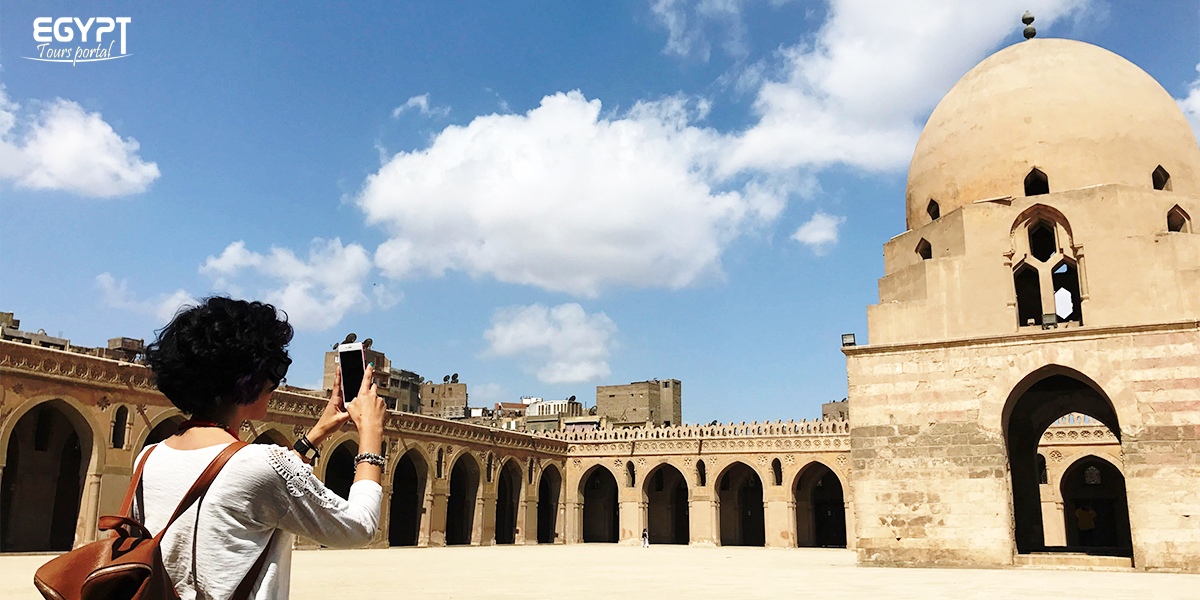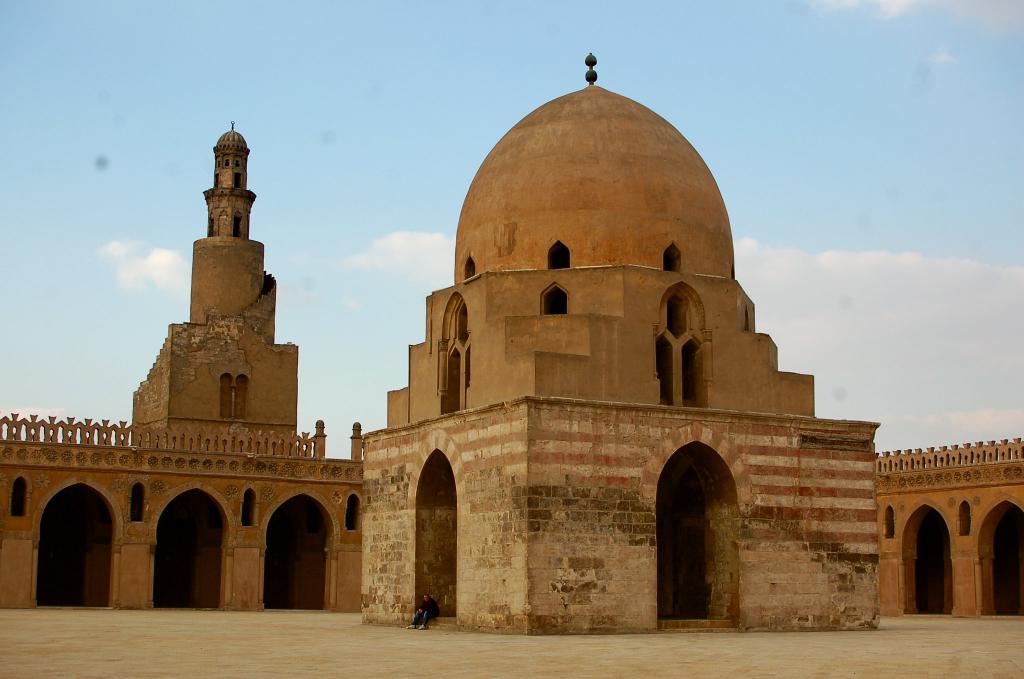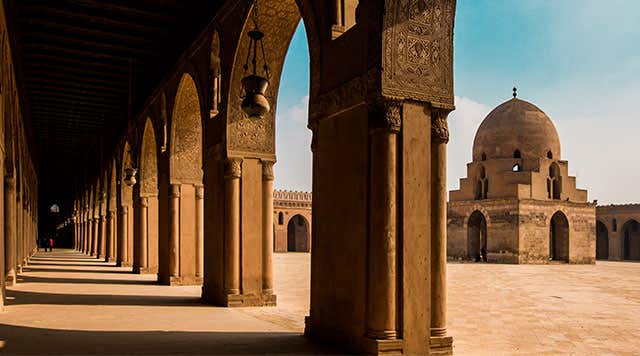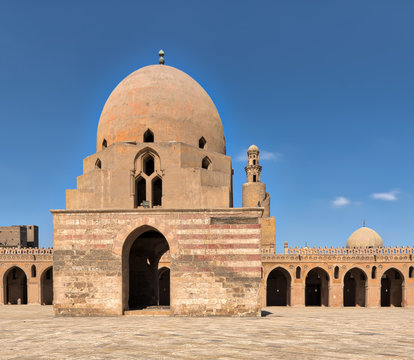The Mosque of Ibn Tulun: A Must-Visit for Any Egypt Travel Guide

I. Introduction to the Mosque of Ibn Tulun
The Mosque of Ibn Tulun is a historic and significant landmark in Cairo, Egypt. It is one of Egypt's oldest and largest mosques and is a must-visit for any Egypt travel guide. The mosque holds great historical and architectural significance, attracting visitors worldwide.
Overview of the historical significance
The Mosque of Ibn Tulun was built in the 9th century and is named after its founder, Ahmad ibn Tulun, who was the ruler of Egypt at that time. It was constructed as a congregational mosque for the people of Egypt and remained an active place of worship. The mosque played a significant role in medieval Egypt's religious and cultural life and has witnessed many historical events over the centuries.
The mosque is noteworthy due to its association with the Tulunid dynasty, who ruled Egypt during the Abbasid era. It represents a unique architectural style combining early Islamic, Coptic, and Abbasid design elements. The mosque's historical significance lies in its survival through various dynasties and rulers, making it an important symbol of Egypt's rich history.
Architectural features and design
The Mosque of Ibn Tulun features a distinctive architectural style that sets it apart from other mosques in Egypt. Its design showcases a blend of traditional Islamic and unique elements inspired by the architecture of Samarra, Iraq. Some noteworthy architectural features of the mosque include:
1. The Large Hypostyle Hall: The mosque boasts a large hypostyle hall with a central courtyard surrounded by arcades supported by marble pillars. The hall is adorned with intricate carvings and geometric patterns, creating a visually stunning sight.
2. The Spiral Minaret: One of the mosque's most famous features is its spiral minaret. It stands at an impressive height of 165 feet and offers panoramic views of the surrounding area. Climbing up the minaret is a memorable experience for visitors.
3. The Fountain: The mosque has a beautiful fountain located in the central courtyard. The fountain is made of carved marble and is a source of ablution for worshippers.
4. The Prayer Hall: The prayer hall is spacious and accommodates many worshippers. Its simple yet elegant design creates a peaceful atmosphere.
Overall, the Mosque of Ibn Tulun is an architectural masterpiece that reflects Egypt's rich cultural heritage. It's historical significance and unique design make it a must-visit attraction for anyone interested in exploring Egypt's history and Islamic architecture.
For more information about the Mosque of Ibn Tulun, you can visit its Wikipedia page.

II. History of the Mosque of Ibn Tulun
Origins and construction
The Mosque of Ibn Tulun is one of the oldest and most significant historical sites in Cairo, Egypt, and it is a must-visit for any traveller interested in the country's rich history and architecture. Built-in the ninth century during the Abbasid period, the mosque was commissioned by Ahmad ibn Tulun, the Abbasid governor of Egypt at the time.
The mosque's construction began in 876 AD and was completed in 879 AD. The mosque's design is influenced by the architectural styles of both the Abbasid and Fatimid periods, resulting in a unique and impressive structure. The mosque is known for its massive size, simple yet elegant design, and the use of local materials such as brick and wood.
Notable events and renovations
Over the centuries, the Mosque of Ibn Tulun has witnessed several notable events and renovations. During the Fatimid period, the mosque was expanded and renovated, serving as Cairo's central religious and cultural hub. It continued to play an essential role in the city's religious and cultural life throughout the Ayyubid and Mamluk periods.
In the 19th century, the mosque underwent a significant restoration project led by the Egyptian Antiquities Service. This restoration helped preserve the mosque's original features and ensure its longevity. Today, the mosque stands as a testament to Egypt's architectural heritage and serves as an active place of worship for the local Muslim community.
You can find more information about the fascinating history and significance of the Mosque of Ibn Tulun on Wikipedia.
Visiting the Mosque of Ibn Tulun allows you to step back in time and experience Egypt's rich history and culture. With its architectural grandeur and serene atmosphere, the mosque offers a unique and memorable experience for travellers from around the world.

III. Architectural Features of the Mosque
Distinctive elements and symbols
The Mosque of Ibn Tulun is renowned for its unique architectural features and rich symbolism. Here are some notable elements of this historic mosque:
1. Spiral Minaret: One of the most distinctive features of the Mosque of Ibn Tulun is its spiral minaret. This architectural marvel is rare in Islamic architecture and adds to the mosque's charm and grandeur. The minaret is accessible through a spiral staircase and offers panoramic views of Cairo.
2. Large Open Courtyard: The mosque boasts a spacious courtyard, which serves as a gathering place for worshippers. Arcades surround the courtyard and feature beautifully carved wooden screens that enhance the mosque's aesthetics.
3. Central Sanctuary: At the mosque's centre is the main sanctuary, which holds the designated prayer space. It features an ornate mihrab (prayer niche) that indicates the direction of Mecca, as well as a pulpit (minbar) from which sermons are delivered.
4. Mashrabiya Screens: The Mosque of Ibn Tulun is adorned with intricately carved wooden screens known as mashrabiya. These screens serve both functional and decorative purposes. They provide privacy and shade while allowing air to circulate, and their geometric patterns add a touch of elegance to the mosque's interior.
5. Decorative Elements: The mosque is decorated with intricate stucco carvings, geometric patterns, and Quranic calligraphy, reflecting the artistry and craftsmanship of the era. The walls and pillars are adorned with floral motifs and verses from the Quran, creating a visually stunning and spiritually uplifting ambience.
Layout and Floor Plan
The Mosque of Ibn Tulun follows a traditional Islamic architectural layout, with a clear division between public and private areas. Here are the main areas and their functions:
1. Courtyard: The large open courtyard serves as the central gathering space for worshippers and can accommodate many people during prayer times.
2. Sahn: Adjacent to the courtyard is a smaller rectangular courtyard known as Sahn. This area typically contains ablution fountains, where worshippers perform ritual cleansing before prayer.
3. Main Sanctuary: At the heart of the mosque is the main sanctuary, where congregational prayers are held. As mentioned earlier, this area is characterized by the presence of the mihrab and minbar.
4. Pulpit: The pulpit (minbar) is situated near the front of the mosque, typically to the right of the mihrab. It is used by the imam or leader of the prayer congregation to deliver sermons.
5. Side Rooms: The mosque features several side rooms that serve various purposes, such as administrative offices, classrooms, and libraries. These rooms are used for educational, cultural, and community activities.
The architecture of the Mosque of Ibn Tulun is a testament to the artistic and architectural brilliance of the Islamic civilization. Its distinct features and meticulous design make it a must-visit attraction for anyone exploring Egypt's rich cultural heritage.

IV. Decorative Elements and Artwork
The Mosque of Ibn Tulun is renowned for its stunning decorative elements and artwork that showcase the intricate craftsmanship of Islamic architecture. Here are some of the standout features:
Intricate Woodwork and Calligraphy
The woodwork in the Mosque of Ibn Tulun is a sight to behold. The intricate carvings on the doors, screens, and mihrab (prayer niche) display the mastery of the craftsmen who worked on them. The woodwork is often adorned with delicate geometric patterns and calligraphy from the Quran, adding a touch of elegance and spiritual significance to the mosque.
Islamic Motifs and Patterns
The mosque is adorned with intricate Islamic motifs and patterns, creating a mesmerizing visual experience. The geometric patterns, often seen on the mosque's columns, walls, and archways, are a characteristic feature of Islamic art and architecture. These patterns symbolize unity, harmony, and the infinite nature of Allah and add a sense of grandeur to the mosque's interior.
The mosque's courtyard also features a beautiful fountain surrounded by intricate tilework. The tiles are adorned with floral and geometric patterns, contributing to the mosque's overall aesthetic appeal and creating a serene atmosphere.
To learn more about Islamic art and architecture, you can visit Wikipedia.
Visiting the Mosque of Ibn Tulun is a truly immersive experience, allowing you to appreciate the beauty and richness of Islamic art and architecture. Include it in your Egypt travel itinerary for a memorable and culturally enriching experience.

V. The Courtyard and Minaret
Design and purpose of the courtyard
The Mosque of Ibn Tulun in Egypt is not only known for its remarkable architectural features but also for its beautiful courtyard. The courtyard is an essential part of the mosque's design and serves several purposes:
1. Gathering Space: The courtyard serves as a gathering space for worshippers, providing a place to come together before and after prayers.
2. Open-air Tranquility: The courtyard offers a serene and peaceful environment away from the bustling city streets. Its open-air design allows natural light to illuminate the space, creating a calming atmosphere.
3. Ritual Cleansing: In Islamic tradition, before entering the prayer hall, worshippers must perform ablution, a ritual cleansing. The courtyard provides the necessary facilities for performing ablution, including water fountains or ablution areas.
4. Access to the Prayer Hall: The courtyard acts as a transition space between the mosque's exterior and interior. It provides access to the prayer hall, where worshippers gather for prayers.
Overall, the courtyard of the Mosque of Ibn Tulun is designed to enhance the spiritual experience of visitors and create a sense of unity within the mosque.
Description of the elegant minaret
One of the standout features of the Mosque of Ibn Tulun is its elegant minaret. The minaret, also known as a tower, is an important architectural element in mosques and serves as the place where the call to prayer is made. Here are some noteworthy details about the minaret:
1. Tall and Slim: The minaret of the Mosque of Ibn Tulun stands tall and slim, reaching approximately 90 feet. Its slender form adds to the mosque's visual appeal.
2. Spiral Ramp: Unlike many minarets with staircases, the Mosque of Ibn Tulun minaret features a unique spiral ramp. The ramp allows the muezzin (who calls Muslims to prayer) to ascend to the top of the minaret more easily.
3. Ornate Decoration: The minaret is adorned with intricate carvings and decorative elements, showcasing the exquisite craftsmanship of the time. These ornate details add to the visual beauty of the minaret.
4. Spectacular View: Climbing to the top of the minaret offers visitors a breathtaking view of the surrounding area. From this vantage point, one can see the entire mosque and enjoy panoramic city views.
The elegant minaret of the Mosque of Ibn Tulun is a testament to the rich architectural heritage of Egypt and adds to the overall grandeur of the mosque.
Visiting the Mosque of Ibn Tulun and experiencing its courtyard and minaret is essential to any Egypt travel guide. These architectural features' unique design and historical significance make the mosque a must-visit destination for anyone interested in exploring Egypt's rich culture and heritage.

VI. Alabaster Mosque and Sabil
Exploration of the adjacent structures
The Mosque of Ibn Tulun is not the only notable structure within its complex. Adjacent to the mosque, you will find the Alabaster Mosque and Sabil.
The Alabaster Mosque, also known as the Mosque of Sultan al-Muayyad, is a beautiful addition to the complex. It features intricate details and stunning architecture, making it a must-visit for any enthusiast. The mosque is named after the material used in its construction, alabaster, which gives it a unique and elegant appearance. Take the time to explore its interior and marvel at its craftsmanship.
Next to the Alabaster Mosque, you will find the Sabil. A Sabil is a public drinking fountain commonly found in historical Islamic cities. These fountains were built to provide clean drinking water to the public, as access to clean water was crucial, especially in arid regions like Egypt. The Sabil adjacent to the Mosque of Ibn Tulun is a testament to these structures' architectural and functional importance in Islamic society.
Importance and function in the complex
The Alabaster Mosque and the Sabil play important roles within the Mosque of Ibn Tulun complex.
The Alabaster Mosque serves as a place of worship where Muslims can gather for prayers and religious ceremonies. Its grandeur and beauty add to the spiritual experience of those who visit it. The intricate architectural details and design elements showcase the skill and craftsmanship of the artists and builders of the time.
On the other hand, the Sabil serves a practical purpose. It provides clean drinking water to visitors to the mosque and the surrounding area. This was especially important in a time when access to clean water was limited. The Sabil fulfilled a basic human need and served as a charitable act of providing for the community.
The Alabaster Mosque and Sabil contribute to the overall significance and function of the Mosque of Ibn Tulun complex. They showcase the architectural beauty and cultural significance of Islamic architecture in Egypt.
Visiting the Alabaster Mosque and Sabil allows visitors to experience the artistry and functionality of these structures, further enriching their understanding of Islamic culture and history in Egypt.

VII. Ibn Tulun Museum
Overview of the museum's exhibits
The Ibn Tulun Museum is a must-visit destination for anyone exploring Cairo, Egypt. Located within the historic Ibn Tulun Mosque complex; the museum houses a fascinating collection of artefacts that offer a glimpse into Egypt's rich cultural and Islamic heritage.
Inside the museum, visitors can explore a variety of exhibits that showcase artwork, manuscripts, textiles, and other objects of historical significance. Some of the highlights include:
-
Islamic Calligraphy: The museum displays exquisite examples of Islamic calligraphy, considered a form of artistic expression in Islamic culture. Visitors can admire the intricate designs and beautiful script adoring these works of art.
-
Islamic Art: The museum's collection features a wide range of Islamic art, including ceramics, metalwork, woodwork, and textiles. These pieces showcase the skill and craftsmanship of Muslim artisans throughout the centuries.
-
Qur'an Manuscripts: The museum is home to several Qur'an manuscripts, some of which date back to the early Islamic period. These manuscripts are religious texts prized for their intricate calligraphy and decorative illustrations.
-
Historical Artefacts: The museum also houses a collection of historical artefacts, including coins, jewellery, and everyday objects used by people in ancient Egypt. These artefacts provide a fascinating insight into the daily lives of Egyptians throughout history.
Connection to the mosque's history
The Ibn Tulun Museum is closely connected to the history of the Ibn Tulun Mosque, as it is housed within its complex. The mosque is one of the oldest and largest mosques in Egypt, built in the 9th century by Ahmad ibn Tulun, the founder of the Tulunid dynasty.
The museum was established in 1881 to preserve and showcase the cultural and historical significance of the mosque and its surroundings. It was renovated and expanded over the years to accommodate the growing collection of artefacts.
Visitors to the museum can appreciate the exhibits and explore the architectural marvels of the mosque complex. The museum's collection and stunning Islamic architecture make this a truly enriching and educational experience for travellers.
For those interested in learning more about the Ibn Tulun Museum and its connection to Egypt's history, here is a helpful link.
